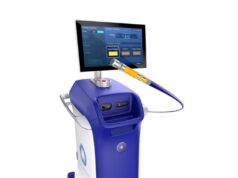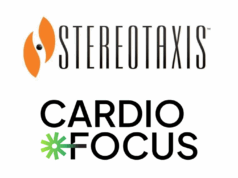
The treatment of atrial fibrillation (AF) via a novel, ‘single-shot’ spherical array approach to pulsed field ablation (PFA) has been found to achieve durable and safe creation of cardiac tissue lesions, translating into “good clinical efficacy”, at one-year follow-up. That is according to the latest data from the first-in-human PULSE-EU trial evaluating the Globe PFA system (Kardium).
These findings were presented for the first time at the Heart Rhythm Society (HRS) annual meeting (16–19 May, Boston, USA) earlier this year and have more recently been published in the journal Heart Rhythm.
“I am very excited by the results of the PULSE-EU study with the Globe pulsed field system,” said Vivek Reddy (Mount Sinai Hospital, New York, USA), who presented the data at HRS 2024. “The Globe system achieved excellent freedom from atrial arrhythmia in both paroxysmal and persistent patients, with no device- or procedure-related major adverse events. These outcomes underscore the tremendous potential of the Globe system in advancing AF treatment and improving patient outcomes.”
Reporting one-year outcomes from PULSE-EU in full in Heart Rhythm, Reddy and colleagues note that electrode-tissue proximity “optimises lesion quality” within PFA procedures.
As such, their first-in-human study intended to assess the ability of Kardium’s novel, single-shot, ‘map-and-ablate’ spherical array multielectrode PFA catheter to verify electrode-tissue contact—and, ultimately, what bearing this has on AF treatment outcomes. Lesion durability, safety, and 12-month effectiveness outcomes, were among the key goals of PULSE-EU.
Reddy et al detail that the catheter—an “all-in-one mapping and ablation system”—was used to render anatomy and deliver biphasic, ungated 1.7kV pulses at a rate of roughly 40 seconds per application. Ablation sites included pulmonary veins (PVs) and, in selected patients, posterior wall and mitral isthmus. Follow-up involved invasive remapping at about three months, electrocardiograms, Holter monitoring at six and 12 months, and symptomatic and scheduled transtelephonic monitoring.
The study’s primary and secondary efficacy endpoints included acute PV isolation (PVI), PVI durability, and atrial arrhythmia recurrence, the authors note. Across a cohort of 48 AF patients—including 48% paroxysmal and 52% persistent AF types—lesion sets included PVI (n=48; 1.2 applications/PV), posterior wall (n=20; 3.6 applications/posterior wall), and mitral isthmus (n=11; 2.9 applications/mitral isthmus).
Reddy et al relay that the Globe system demonstrated durable clinical effectiveness in the study, with lesion creation being acutely successful for all 187 PVIs (100%), as well as all 20 posterior walls (100%) and 10 of 11 mitral isthmuses (91%).
In addition, pulse delivery time, left atrial catheter dwell time and procedure time were 61.5 seconds, 53.9 minutes, and 87.8 minutes, respectively, while the average time across all acute PVIs was 23 minutes and the average fluoroscopy time was 5.3 minutes. Remapping—completed in 43 of 48 patients (89.5%)—revealed that 158 of 169 PVs (93.5%) were durably isolated.
The only complication observed in the study was a case of drug-responsive pericarditis, with zero device- or procedure-related major adverse events being reported. Silent cerebral events were observed on postprocedural magnetic resonance imaging (MRI) in two of 38 patients (5%), but neither of these patients had neurologic symptoms, and there were no instances of oesophageal injury, phrenic nerve injury or significant PV stenosis. Additionally, the one-year Kaplan-Meier estimates of freedom from atrial arrhythmia were found to be 84.2% and 80% for paroxysmal AF and persistent AF, respectively, according to Reddy and colleagues.
“It is widely recognised that establishing durable PVI is crucial for improving long-term freedom from recurrent atrial arrhythmias,” Reddy et al write. “With use of the spherical array PFA catheter and electroanatomic system, a high level of PVI durability was attained, leading to a one-year clinical success rate of 84.2% in paroxysmal AF and 80% in persistent AF. This notable success—achieved with just an average of 1.2 PF applications per PV and approximately 60 seconds of PF application time per patient—may be attributed to several factors: the optimal electrode-tissue contact, enhancing the penetration of the electric field into the tissue; the large spherical array design, facilitating significant contact of the ablative electrodes with the targeted atrial tissue when positioned at the PV ostia; and the expansive ablative footprint, resulting in an antral-level isolation, as observed in invasive remapping studies.”
Reddy reports the following disclosures: he receives consulting fees (and equity) from Kardium Inc; and unrelated to this manuscript, he also serves as a consultant for and has equity in Ablacon, Acutus Medical, Affera-Medtronic, Anumana, Apama Medical–Boston Scientific, APN Health, Aquaheart, Atacor, Autonomix, Axon Therapies, Backbeat, BioSig, CardiaCare, Cardiofocus, CardioNXT/AFTx, Circa Scientific, CoRISMA, Corvia Medical, Dinova-Hangzhou DiNovA EP Technology, East End Medical, EPD-Philips, EP Frontiers, Epix Therapeutics–Medtronic, EpiEP, Eximo, Farapulse–Boston Scientific, Field Medical, Focused Therapeutics, HRT, Intershunt, Javelin, Keystone Heart, Laminar Medical, LuxMed, Medlumics, Middlepeak, Neutrace, Nuvera–Biosense Webster, Oracle Health, Restore Medical, Sirona Medical, SoundCath, Valcare; unrelated to this work, he has served as a consultant for Abbott, Adagio Medical, Append Medical, AtriAN, Biosense Webster, BioTel Heart, Biotronik, Boston Scientific, Cairdac, Cardionomic, CoreMap, Fire1, Gore & Associates, Impulse Dynamics, Medtronic, Novartis, Novo Nordisk, Philips, Pulse Biosciences; and unrelated to this work, he has equity in Atraverse, DRS Vascular, Manual Surgical Sciences, Newpace, Nyra Medical, Soundcath, Surecor, and Vizaramed.









